Dancing
with Everything
The Art of Grieving Through Music

My grandsons, Ethan and Will, were nine and six years old respectively when I watched their mother interrupt a fight they were having. She had clearly done this before, and I saw that she had some skill in getting the boys to each look at the situation from the other’s point of view. After some discussion, she instructed them to each apologize to one another. Ethan, the eldest, went first. With his head cocked to the side, he said, “I’m sorry.”
Will came back quickly and strong with “Oh no, you’ re not! You’re just over there singing to yourself.”
I was able to stay in my role as fair witness, but it was hard not to laugh and somewhat agree with Will because I knew that, as a musically inclined child, Ethan did sing to himself often. I’ve always wondered if that’s how he keeps himself in such an even-tempered and emotionally positive place.
My grandsons are grown men now. There are many principles I hope I have shared with them, many truths I would like them to remember and embody, with one of the most important being that the capacity of music to facilitate a change in one’s emotional state is enormous. As we know from African American spirituals, known as “sorrow songs,” and from a more recent form of music, the blues, music can express for us the emotions inherent in our grief, and take us in a progression from negative to positive, from discordant to resolved.
Physician Oliver Sachs, author of Musicophia: Tales of Music and the Brain, reminds us that “music occupies more areas of the brain than language does—humans are a musical species.” It can be hard to find the right words to describe the progress on our grief journeys. Hopefully, most people know that the goal is not to “get over it” and “move on.” Sometimes we talk about “healing” our grief, but grief isn’t an illness, so unless we are referring to the trauma associated with some losses that needs healing that word doesn’t fit. Arriving at a “resolution” has possibilities, except that word usually means finding a solution to a problem or a puzzle. And grief, though it can be puzzling, is not a problem to be solved. As my friends, students and fellow interplay playmates have been teaching me more about music, I get excited by the possibility that music theory might have a suggestion for us. In Western tonal music theory, the term “resolution” is the move of a note or chord from dissonance (an unstable sound) to a consonance (a more final or stable sounding one). (Jett demonstrates on the piano.)
That fits with grief—a journey from and through instability to stability. That got me thinking about what music offers our grief journeys, not just as a metaphor but as medicine. Could music bring us through an episode of grief to a resolution, for now? As with other arts, can music be a vehicle to take us into our grief, help us process it, and bring us out?
Please join me as I will be meeting with some colleagues, artists, and musicians online this Thursday evening to explore answers to these questions. Western culture’s rule for human contact in adverse situations being some version of “Keep calm and carry on, and whatever you do, don’t become emotional –sets up a need for music to connect us with our emotions. On the path of good grieving, we must be able to recognize, accept and express our emotions. And to be good companions to loved ones as they grieve, we must be able to allow them to have and express their emotions in our presence. Opera singer Elizabeth Jett Downing will demonstrate how that’s done as she shares a tribute to tears, a lament from Werther Act III: music by Jules Massenet libretto by Edouard Blau, Paul Milliet and Georges Hartmann, 1892, “Va, laisse couler mes larmes, Oh, let my tears keep on flowing.”
Here is the link to the Reimagine online Art of Grieving event with a focus on Music as grief’s collaborator. https://letsreimagine.org/76768/the-art-of-grieving-series-music
See you there April 18th at 7:30 pm eastern time on the Reimagine platform.
Sheila
PS – In case you missed it, as of last Tuesday The Art of Grieving is available for pre-order on Amazon. Here’s the link: https://a.co/d/fCLchkf
Art of Grieving Lessons from the Eclipse
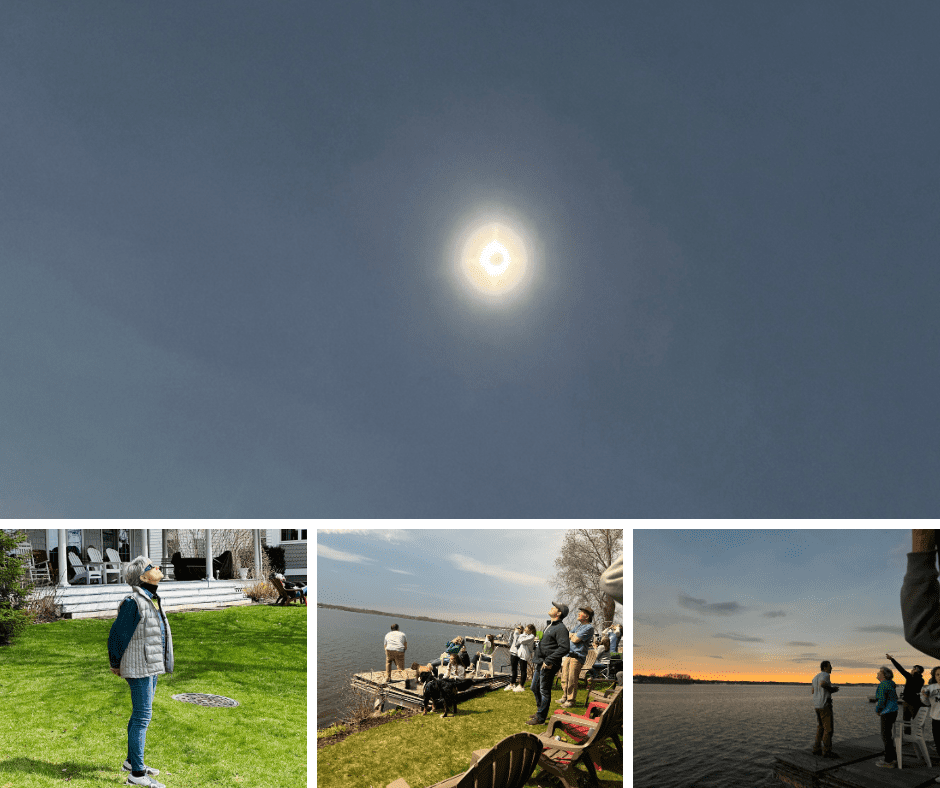
My husband and I are on the shores of Lake Conneaut, the largest natural lake in the state of Pennsylvania. We’re meeting for the first-time, relatives and friends of our Pittsburgh neighbors who share a century old summer cottage on the lake. We’ve driven several hours to this place, which is close to the center of the path of totality, to view the 2024 eclipse. It wasn’t a certainty we would make it in time since I had a morning doctor’s appointment I couldn’t reschedule. The doctor’s next available appointment is late fall.
First contact has already begun as we arrive. We’re invited to occupy one of the green plastic Adirondack chairs facing the lake and the panoramic view of the in and out sun and cloud filled sky. Children and dogs scamper about while our hosts make sure we meet everyone, know where the snack table is and how to find the rest rooms.
Now several days later we can ask, and perhaps answer, the questions the experience generated. What did we learn and was it worth it? Was it worth the advance planning to secure protective glasses, interrupt our normal Monday schedule to travel throughout the countryside and back on alternating traffic filled roads –all to view for a few minutes the shadow of the moon slowly, eventually, covering the sun?
“One half the people cry when they see it,” a 40s something man says as we all struggle with our glasses to see a clear image of what’s happening in the sky dance of sun, moon, and clouds. “Is anyone crying?” he asks and members of the viewing group laugh at this notion. I place my hands over my ears to block the distraction as this theme repeats–“How about now? Is anyone crying yet?” Again, more laughter and occasionally people pretending to cry. “No fake crying, the man declares. It has to be real.”
I agree with the man that tears must be real. As a grief advocate it is difficult for me to experience people’s confusion and shame around tears, their own and other peoples. When tears occur in circumstances like witnessing an eclipse, they are not necessarily tears of sadness. They can be an expression of awe and the body’s signal to pay attention. What’s occurring really matters.
Author Dacher Keltner in his book “Awe: The New Science of Everyday Wonder and How it Can Transform Your Life defines the feeling of awe as “being in the presence of something vast that transcends your current understanding of the world.”
The 2024 eclipse is transforming our understanding of the sun, especially for the scientist that are studying it. Each eclipse furthers their understanding of the sun’s dynamic motion. We saw with our naked eyes a bright red dot shooting out from the lower left edge of the solar circle and recognized it as a solar flare. If we hadn’t watched the NOVA show on Eclipses a few nights before we might have missed this idem and for sure, we wouldn’t have known what to call it.
Viewing news broadcasts of interviews with people from around the country I noted that it was important who accompanied or surrounded them during the experience. Parents expressed joy at being able to share the event with their children, mentioning it would be a memory and milestone to connect them later. Kids of all ages meanwhile seemed to revel in the celebratory party atmosphere, recognizing this was an important occasion. For some people, it was the reminder of and connection to loved ones no longer here. For one man, the event pointed to his own mortality – “I’m not likely to be here for the next one, so I thought I should go to this one.” Several people mentioned appreciating the viewing party as a community event that brought people together across the conflictual political and cultural divides of our time. Most everyone’s reaction seemed to demonstrate another of Keltner’s definitions of awe – “Tears of awe signal an awareness of vast things that unite us with others.” It seems it’s the connection to vastness that transforms the ordinary into the memorable and never forgotten extraordinary.
How Visual Arts Help Us Grieve
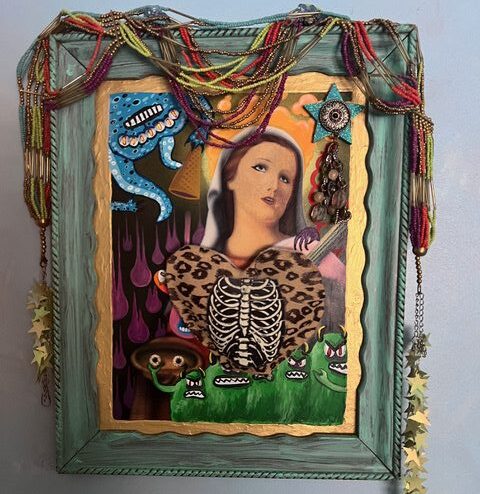
Freud got one important thing wrong about grief. I discovered this when my experiences as a mourner did not always jive with what I had been taught as a social worker and practiced as a therapist. During the time of my university education and study of the great books, theories of grief were based on Freud, who, in his classic volume Mourning and Melancholy, recommended detachment from deceased loved one to move on with one’s own life. Current research supports the opposite, recommending that mourners find ways to continue a relationship with deceased loved ones, now referred to as, “establishing and maintaining continuing bonds.”
Memories are what’s left after the loss of a loved one, and our creativity and various art forms serve to create a place or an object on which to focus those memories. But what if you aren’t an artist and you don’t think of yourself as creative? My colleague and friend, Cynthia Winton-Henry, in addition to being co-founder of InterPlay, an art-based system to unlock the wisdom of the body, a dancer, and author of The Art of Ensoulment: A playbook on How to Create from Body and Soul– Cynthia has a great visual art way to accomplish this continuing connection. She’s a shrine-maker. Cynthia suggests you may be one too.
“If you’ve ever put flowers on a grave, placed a photo of a deceased family member in a prominent place in your home, made an altar with found objects, or displayed your loved one’s memorabilia in a box, you are a shrine-maker already.” I learned the power these found object art pieces can provide when one’s loss is not a death but an injury, or disability. Cynthia gifted me one several year ago, after I’d broken my shoulder.
“You’re not as you were,” the doctor tells me as he shows me the x-ray of my shoulder. The picture means little to me since I’m not totally clear on what the shoulder bones are supposed to look like. During my dance class, I had been moving sideways on a sticky floor and couldn’t get my feet under me in time and landing directly on my left shoulder, I broke it in a couple of places. After the doctor directs me to push against his hands and reach up overhead, he declares, “You are at eighty percent.” I tell him, I’m really not an eighty percent kind of gal, so he gives me a script for more physical therapy. The PT sessions direct the incredible work I must do to get back to my “old self” and my mission in life, which seems to be to become the world’s oldest known person still dancing.
Cynthia had had a shoulder injury a couple of months before mine, (her right shoulder, my left), and she was nearly back to a complete range of motion by this time, which encouraged me to believe such a thing was possible. Her recovery program included all of what I was doing along with her spiritual practice of making art out of what happens in her life. We commiserated about our “broken wings” and when I saw her at a national conference, she gifted me a framed art piece made of found objects, titled, “Our Lady of the Broken Wings.” It still hangs beside my bed, sending memories of the challenges Cynthia and I have both overcome, and reminding me of the loving encouragement the piece provided to the one who created it, the one who received it, and all the love it contained.
Learn more about Cynthia’s shrine making, how to do it, and how such arts help us grieve this Thursday April 4, 2024, at 7:30 pm eastern, 4:30 pm pacific in the 3rd of 5 online events, The Art of Grieving Series–Visual Arts on the Reimagine Platform. The Series is based on my soon to be available book, The Art of Grieving: How Art and Artmaking Help Us Grieve and Live Our Best Lives.
Register here and pay what brings you joy. https://letsreimagine.org/76768/the-art-of-grieving-series-visual-arts
Grieving Our Covid Losses
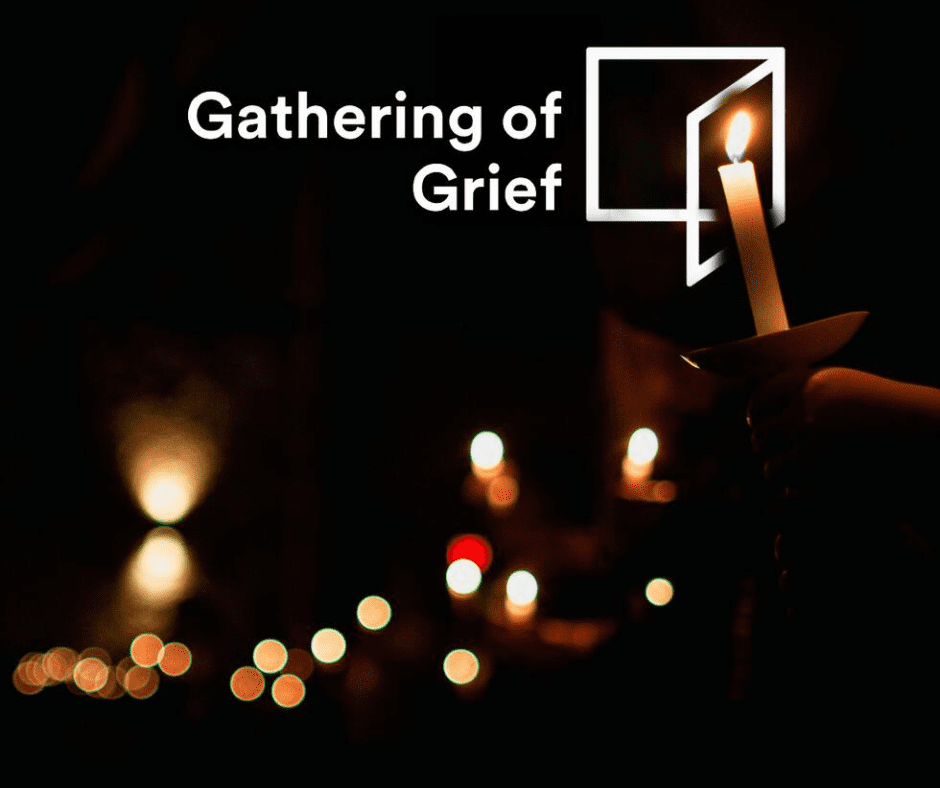
Like many other writers during the Covid pandemic shutdown I decided to use the time I was being given to write a new book. For a grief advocate the situation was offering continuous, unprecedented, multiple examples of losses in need of processing. And, at the bottom line, that’s what grieving is. A year or so into the writing process, I shared the proposal for the book, “The Art of Grieving” with a publishing industry expert. She assured me that publishers were no longer accepting any book that dealt with the pandemic. She said that by the time books currently in production would become available, people would have no interest in that topic.
Here we are now, 4 years after the novel Covid19 virus unleashed a historic disaster on the entire world. And, according to two psychiatrists George Makari and Richard A. Friedman, in a recent article in the Atlantic, “America is in a funk, and no one seems to know why. Unemployment rates are low, and the stock market is high, but poll after poll shows that voters are disgruntled.” The physicians suggest that this funk is not due to the economy, but an important overlooked factor – “the country has not come together to sufficiently acknowledge the tragedy it endured.”
Makari and Friedman point out that recovering from trauma does not happen by ignoring past painful events, and they offer evidence that COVID meets the clinical definition of trauma. It was, and for some, still is, an overwhelming experience threatening serious physical and psychological harm. As research with combat veterans has shown, this setting aside of traumatic experiences without acknowledging and processing them, leads to free-floating anxiety and anger–and to the malaise of our current cultural attitudes. It seems the prevailing attitude is “Life sucks!” And whoever is in charge will get the blame.
I knew as a grief advocate 4 years ago what the publishing industry didn’t seem to–that grieving is an art we need to get good at–the vitality of our life depends on it. Many of us met online, a situation I never imagined would suffice, and in these online communities, even naming our losses, and witnessing others name theirs, offered respite and perspective. In our “isn’t there a pill for that?” culture, it takes some courage to process loss by revisiting the scenes and remembering what transpired during important and challenging times of our individual and communal lives. When we go back in rituals of remembering we discover not only loss but gift and gain.
I’d like more people to know about the Reimagine Virtual Candlelight Vigils that have been happening monthly since COVID first appeared. People from around the globe have been honoring loved ones, holding space for grief, and using the arts to reflect on the possibilities of transformation. Checkout this amazing resource. https://letsreimagine.org/76768/reimagine-candlelight-vigil-with-david-henry-hwang
Now that my book is about ready to come out, I’m eager to share what I’ve been learning about how the arts of music and storytelling, dance and writing, and visual art making can help us process and discover our best lives. For advanced notices go to http://lp.constantcontactpages.com/cu/aM1xtoL/artofgrieving
Revisiting together from the perspective that time provides, and with the wisdom we have now gained encourages post traumatic growth.
- In revisiting the scene from the perspective of several years, keep in mind the gifts. No losses without gains – list
- Reimagine Virtual Candlelight Vigil Let’s honor our loved ones, hold space for grief, and reflect on the possibilities of transformation
- The gifts
Over a million lives were loss in the US, with family members denied the opportunity to say goodbye, while xxx others still bear the health challenges of long COVID.
The Art of Dancing at a Memorial
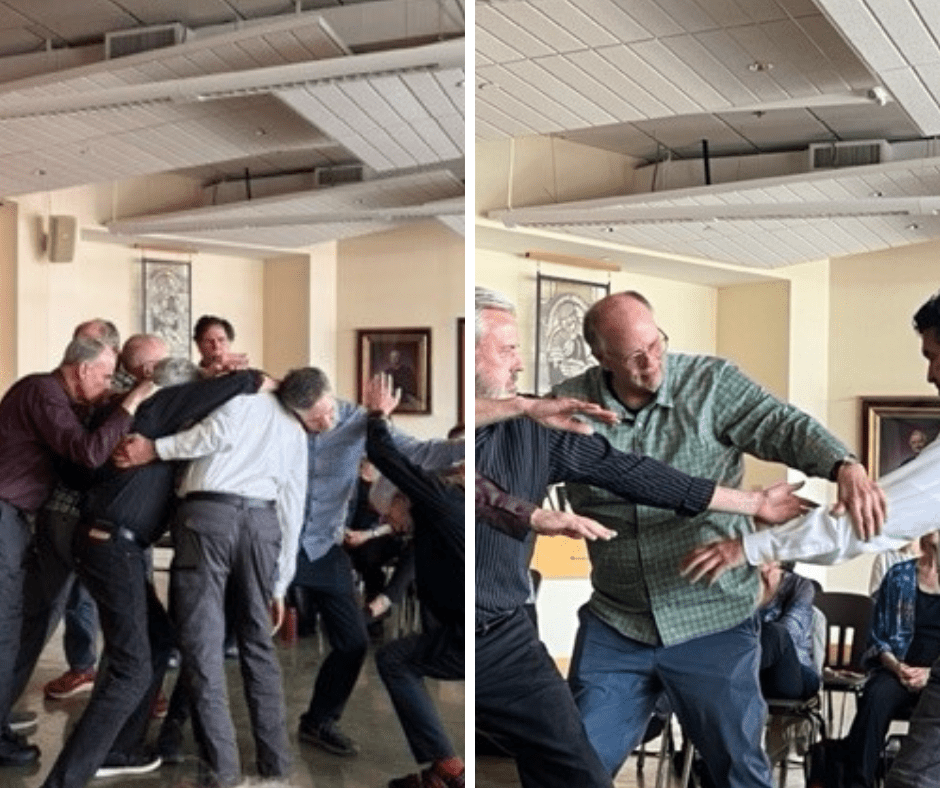
My husband and I couldn’t afford the time to drive to Raleigh NC to attend a memorial celebration for a long time InterPlay friend, so we flew on the new Breeze airline. It definitely lived up to its name. The short trip had us relaxed and rested to participate in what we knew, would be an energetic, novel, and fun experience.
For an elder like Tom Henderson, we expected the memorial event to honor him and his well-lived life. We were surprised by what Tom had prearranged for us. You’ve probably heard the advice to pre-arrange your funeral and burial to lessen the burden family members. Let people know what songs you want sung, what poems or scripture segments read. But Tom went a bit further. He offered his own poems. The memorial was a community celebration of our own lives, of the times we shared with Tom and with one another through decades of tough challenges and play-filled celebrations.
Tom was a scientist, a chemist, but also a poet and musician. In this InterPlay community, whose forms are active, creative, improvisational ways to unlock the wisdom of our bodies, Tom was a dancer. And so, we danced on his behalf, using the forms he recommended, in the timings that he wanted them to occur. You might say, he called the show from the other side.
As a white man in our western culture, it is no small achievement to become a dancer. I salute the bravery of Tom, my husband Richard, Billy Amoss and the men Tom and he gathered a dozen or more years ago to form a men’s InterPlay group. The performance of that men’s group was a highlight of our gathering.
Tom’s run of show asked me to lead the Pittsburgh form, a version of community dance and storytelling that many of us present have done with Tom and his wife Ginny, with their community performance troupe, Off the Deep End in North Carolina, in Oakland CA with the Wing It Performance Ensemble, and in Malawi, Australia, and at the Fringe Festival in Scotland.
By his selection of various elements, Tom ignited memories of the rich life we have shared together. We came to see different sides of his personality, through the stories of InterPlay founders, Tom’s students, mentees, and teachers. His saxophone teacher performed a tune from Tom’s favorite jazz musician, John Coltrane. In one of Tom’s poems he ended with the message, “do not waste time in mourning, look, see, create, and choose joy!” Most everyone in that room understands that the dance is the most powerful path to joy.
If you are reading this on Thursday March 21st – join us online for the Reimagine platform The Art of Grieving – Dance at 7:30 -8:45 pm, eastern, 4:30-5:45 pm pacific. Register here https://letsreimagine.org/76768/the-art-of-grieving-series-dance
The Creative Process and What Keeps Us Going On
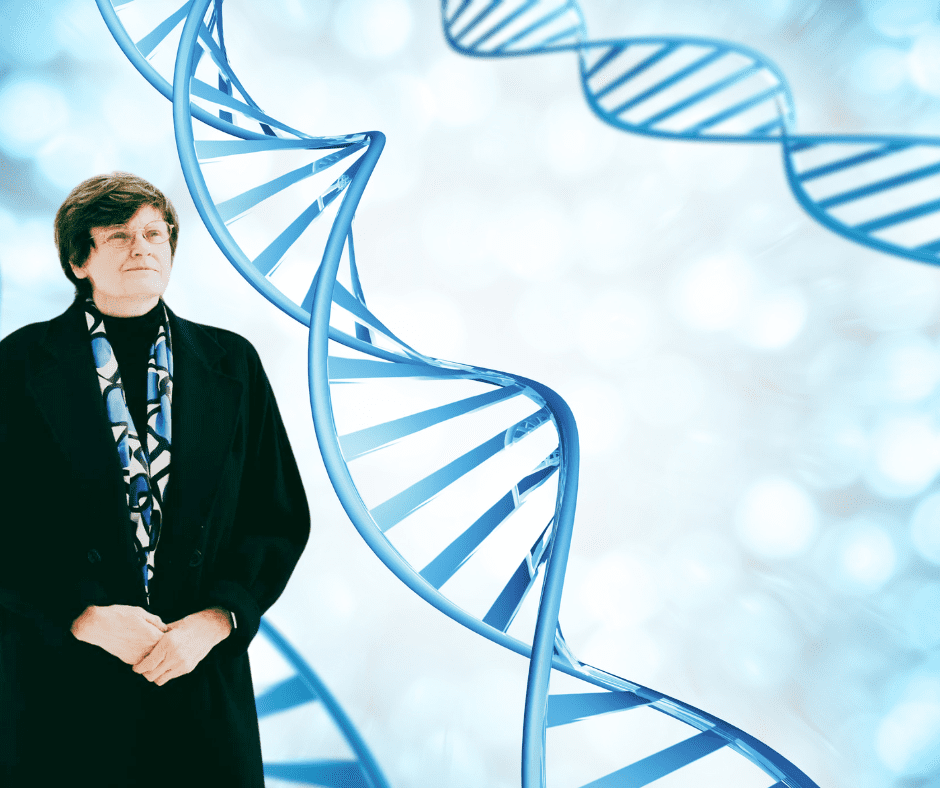
“When can I get an actual book?” my friends ask me, and it reminds me again of how long creative projects take. The ideas and inspiration can take seconds but the implementation–years. In fact, lots of things take longer than we can ever imagine, especially if interrupted by much that is outside of our control. It was a lesson I thought I’d learned during the pandemic. When it first appeared in March of 2020, no one had any real idea how long it would last. Looking back now, we see that the messenger RNA vaccines that became available in December took no time at all. In fact, that’s part of what created suspicion about them. How much testing could have possibly been done to make sure they were safe?
I came across a television interview with the two scientists who won the Nobel Peace Prize in October of 2023 for the Covid 19 vaccine and learned that after a chance meeting at the copy machine, it took Katalin Kariko’ PhD and Drew Weissman, MD, PhD 15 years for their visionary laboratory partnership to make an everlasting imprint on medicine. Dr. Kariko’ has spent her entire 40 + career on messenger RNA. And all those things along the way that interfered make Kariko’, just in time for Women’s History month, a poster woman example of what must be overcome to keep going on.
Born in Hungary, Kati, as she is known to her colleagues came to the United States 40 years ago but for decades did not have a tenured position, working in “soft money” research assistant positions and having to relocate whenever the money or sponsor moved on. Her husband, who is not a scientist would tell her, according to an account in a terrific 2021 article by Gina Kolata, in the New York Times, “You are not going to work–you are going to have fun.” A businessman, he once calculated that with all the hours she put in at the lab she was earning about a dollar an hour. Kolata’s interview quotes Dr David Langer, a neurosurgeon who has worked with Dr Kariko’, “When your idea is against conventional wisdom that makes sense to the star chamber, it is very hard to break out.” Her ideas were definitely unorthodox and ahead of their time.
I wish someone would have told me, earlier in my own career, what it takes for a creative in any field to keep true to their vision and keep going on. The suffragette Susan B Anthony’s claim that “failure is impossible” may be true but pardon we women for wondering if such accomplishments will happen in our own lifetimes. Using Kati’s career as a model, the keeping on happens when you’re doing what you love and having fun in the process. I can agree with that and pass on to the next generation a trick I’ve discovered through my own career–just the right music, played at the right time can lift you up and carry you over the rough patches in the present discouraging terrain. (Try the Keep Going Song by The Bengsons – https://www.youtube.com/watch?v=Cs-ju_L9pEQ https://www.youtube.com/watch?v=Cs-ju_L9pE
The Art of Dancing on Behalf of Peace Part 2
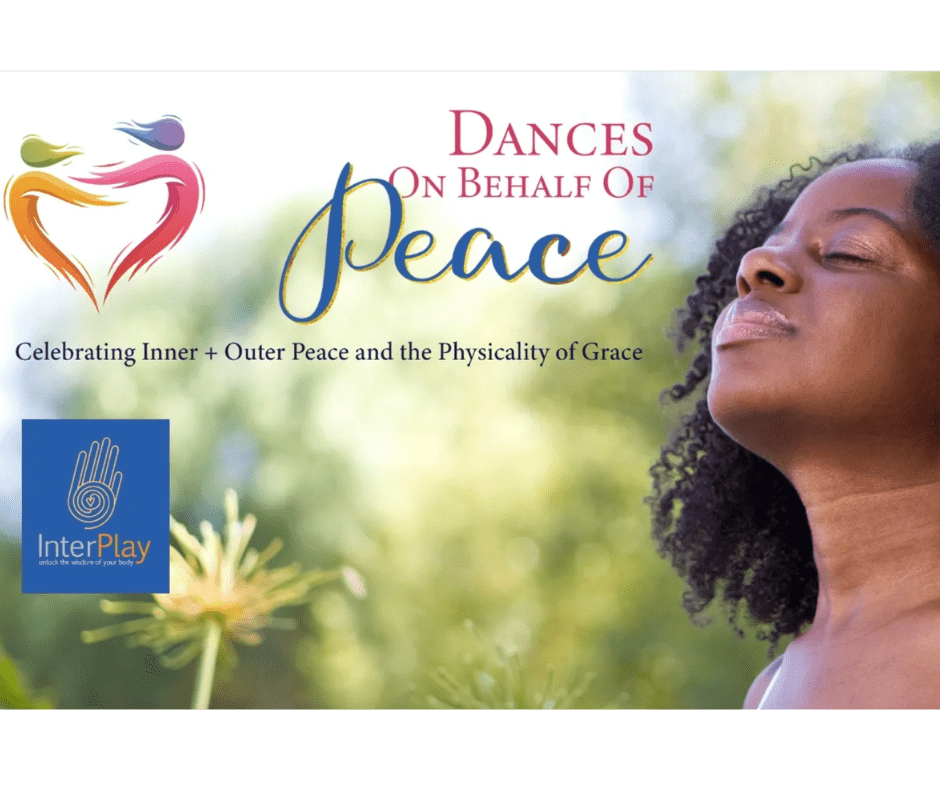
“What is she doing? My 3-year-old grandson William’s voice echoed throughout the large meeting space at my 31-year-old son Kenneth’s memorial service. Hearing that voice, and the question that I imaged many other people were asking themselves, I stopped what I was doing. I went over to him were he was seated with his parents in the front row. “I’m dancing on behalf of Uncle Ken,” I said. “Would you like to dance with me?” Without hesitation, he buried his head in his mother’s pregnant lap and shook his head vigorously no. But his 5-year-old brother Ethan, stood up, took my extended hand, and joined me. We danced together in a circular pattern in the open space. I lifted him up and we twirled around together. My breath quickened and my heart filled with joy. I’m transported back to when my youngest son Ken was 5 years old. Here in these moments of my greatest sorrow, tears remind me of the tremendous joy that Ken’s life had brought to mine.
Dancing and grieving share a similar status in western culture. They are both to be avoided in order to maintain ones’ composure. That evening, I thanked Ethan for dancing with me. Will explained why he rejected my offer. “I don’t dance,” he said with firm conviction. I asked him what he does do. He said, “I golf.”
Many people won’t dance, refuse to dance, yet, in these hard times– Alice Walker maintains “Hard Times Call for Furious Dancing!” Those of us willing to dance need to dance on behalf of those who won’t or can’t. The popular notion of dance is that it is an energetic celebration of positive moments in life, like weddings, birthdays, and graduations. Less well-known is that dance can also be an act of mourning, a full-bodied communal expression of life’s challenges and ways to grapple with them. It is a dual strength of dance that it can help us navigate all our milestone events, which are often a mixture of joy and grief, laughter, and tears.
What does dancing do for the dancer? What will it do for those of us grieving losses, hungering for peace? War and conflicts force people to leave their homes, and all they’ve worked for. If they stay, a good night’s sleep is impossible due to the noise and danger from the bombs. So, if we are to dance on behalf of peace let’s start with a simple gesture, the body’s language for what we sometimes don’t have words for.
Let’s start by making a fist and raising it in the air. That gesture expresses our determination to recognize the injustices of war, and our willingness to stand against it. Seeing other raised hands lets us know we are in solidarity with one another against injustice. To be a peace maker is to know that peace cannot be maintained without justice. But we must let go of the fist, shake it out, and dance can help us do that. That fist that may have become planted in various parts of our bodies, constricting our breath, creating pain, interrupting our rest. Holding on to atrocities and our reactions to them, keep them alive in the world. We must let go, but as Soyinka Rahim reminds, we must do it with love, and that takes dance.
We need rituals for peace so that they will change us individually and collectively. Let me offer a story. In the mid 1980’s a man from Germany visited India and was introduced to a simple ritual, A Universal Peace Greeting from the Gaudi Foundation. The words begin, “I offer you peace.”
And the gestures that went along with it used universal sign language, not the sign language we are familiar with that expresses words in the English Language. Through members in the InterPlay Community, this peace greeting got to me, and I began using it to start and finish classes I taught at the university and staff meetings we held at our behavioral health care clinic in Fort Worth TX. We began by saying to one another, “I offer you peace.”
In 1988, a student of mine was involved with Vivian Casselberry, a Dallas journalist who had formed an organization known as Peacemakers, and they were putting together the First International Women’s Peace Conference. Laurel called and asked that I join them and bring that sheet with the peace greeting on it to the planning meeting. I did that, and each morning of the week-long conference a different delegation of women from one of the 57 countries represented led the conference community of 2000 women in reciting the words of the Peace Greeting in their own native language. We spent a lot of time that week, back and forth to the copy room at the conference center, making copies of the peace greeting for the women to take back to their countries.
The outcome of all this? Barely a year later, November 9th, 1989, the Berlin Wall, which has stood since 1961, came down. Of course, we can’t know for sure that the Peace Ritual had anything to do with that. But I can say for certain, in 1988, though we focused quite a bit on it in our discussions, nobody thought there was much change of that wall being taken down.
Tonight is the final night of Dancing On Behalf of Peace. The event is FREE but you need to register at https://danceonbehalfofpeace.org/
The Art of Dancing on Behalf of Peace

In the midst of these contentious and challenging times, the non-profit organization I have belonged to for over 30 years, Body Wisdom, has joined with other peace-building non-profits and artists to host Dances On Behalf of Peace, an 11 day, half-hour virtual international gathering. I am honored to be a community collaborator and invited speaker for this celebration of Inner + Outer Peace and the Physicality of Grace. The series began Feb. 19th and will meet every evening at 8 pm Eastern, 5 pm Pacific through Feb 29th. https://danceonbehalfofpeace.org/
As you see this invitation you might think, as I often do, even after all these years of dancing on behalf of myself and people and situations needing healing, “Why dance? What good could this possibly do?
Writer Alice Walker expresses it best in the title of one of her poetry books, “Hard Times Call For Furious Dancing.” She states something about dance that many people would say: “I have learned to dance. It isn’t that I didn’t know how to dance. I just didn’t know how basic it is for maintaining balance,” to have, what I call, a vital and satisfying life. And why is that?
A visit to my massage therapist this week pointed out again, that knot in my right shoulder that I imagine would look like a tightly coiled fist if I could see it. I wasn’t aware that it was there, though it’s been there before, and it’s taken quite a lot of effort from her, and relaxation from me, to help it uncinch. I couldn’t feel it until her skilled hands found it. Tense muscles become numb, and feeling can only return when they, we, let go.
I remember years ago accompanying Ilana Rubenfeld as she allowed what she called her “listening hands” to help a Jewish-American man release the tension in his back that had caused him a chronic 40 year, on and off, backache. When asked to remember when he first had the backache he related it to the time, as part of a military unit, when he helped liberate the camps in Germany at the end of World War II. The lesson I took from witnessing this session was– in order to have no more victims we must be able to let go of our reactions to atrocities and stop storing them in our bodies. It keeps the atrocities alive. Frequent dancing is one of the best ways I know to open our clenched fists, wherever in our bodies we have stored them.
Last fall, I was out of the country, off the grid so to speak when war came to people in the middle east. A text from a student who lives in Israel and who regularly attends my online Friday InterPlay class alerted me. The other students and I were so relieved when he got on with us for a few minutes and he seemed delighted to see our smiling faces. After he left, we danced on behalf of David and his family and the dance and the lines of the song took me to a place that its lyrics suggested, “I decided to be happy, I decided to be glad, I decided to be grateful, for all I ever had.”
That evening, I played the song again for myself and moved to it to reinforce those decisions that the song had encouraged me to make. “I decided to be happy, I decided to be glad. I decided to be grateful for all I ever had.” At first, I asked myself, how can you be happy when so many in this world are suffering? But as I danced, it came to me that how can we not be present to what everyone in the conflict is hoping for, for themselves, their families, their communities, and for the world. Could it be an obligation of those of us not living in the center of the storm to keep alive the loving, peaceful energy that the world will need in the future to get us all there?
Join me this evening, and every evening at 8 pm eastern, 5 pm pacific through Feb 29th. The event is FREE but you need to register at https://danceonbehalfofpeace.org/
The Art of Grieving in Service to Love

It’s the day after Valentine’s Day and perhaps the day didn’t go as well for you as the commercials and love songs promised. Your loved one may have spent too much money on flowers that will die rather than a plant you would prefer so you can plant it, or on sweets that aren’t on your eating program. Or you might be the one that was too busy to know what day it even was. In general, our culture makes a big investment in helping us communicate our love to one another. According to the National Retail Federation 53% of consumers in the US will spend $25.8 billion dollars this Valentine’s Day on flowers, dinners, chocolate candy, and cards.
If you’ve been in a relationship for a lot of years you’ve been through some “rough patches.” Maybe you’re still in one of them. Perhaps your relationship ended recently, or your partner is not able to know what day it is. Maybe you are grieving these losses and the secondary losses connected to them. Or you feel the loss of the dream of where you had expected to be in this phase of your life. Perhaps it’s future losses that loom large, so you are grieving something that hasn’t even happened yet.
As I have been researching and writing about grief for almost 10 years, I now ask several “what if” questions. What if we assume, in the art of living a life, that loss is a frequent, episodic occurrence, expected to happen throughout our years, and that grieving needs to be an art we practice and eventually get good at? What if we call on the arts to help us navigate the comings and goings in the love relationships in our lives?
In my family, greeting cards have been a way to honor the relationships we have with one another and to communicate our love. Our daughter Corinne, when she had lost her own hair to chemo treatments sent a Father’s Day card to her stepdad, which he still has on his desk after nearly two decades. The artwork, under the header of “Top Dad Hairstyles,” features cartoon images of men with various patterned baldness hair styles, to honor what she called, “we hair challenged individuals!
It can take quite an investment of time to select just the right card for a specific occasion, or to create one, which becomes a gift of art to the receiver and the giver alike. The image is the message, along with hopefully, just the right few words. This year I re-gifted the card that I had given my husband last year. Like an artist who makes her art out of found objects, when I came across the card in my desk drawer, I knew it carried an image and handwritten message worth repeating. My husband’s card to me this year was a piece of artwork I will be saving, especially since, after his recent participation in a calligraphy class, I can actually decipher his handwriting.
To let loved ones know of our love, we don’t have to spend money in response to the advertisers’ hype, on Valentines’ Day, or any other cultural holiday that ignites the business engines of our economy. The hand painted watercolor image of a butterfly on a get-well card sent to me by a young friend after I had surgery still broadcasts its loving message from the counter in my kitchen where it’s been living for years.
In preparation for next Valentine’s Day–can you picture yourself finding or creating a card to send to yourself as reassurance that you are loveable and loved. Don’t be shy about re-gifting a card that holds a special memory. And imagine playing the song that was always known to you as “our song,” and dancing to the song, either with your partner together in your kitchen, or dancing alone, with a celebratory stemmed glass lifted in honor of the love that began your relationship, and appreciation for your no-longer-present-to you-in-this -life-loved one and the love you shared. Perhaps it’s true that love is the only thing that never dies.
Stay tuned for upcoming news on the launch of my new book, The Art of Grieving: How Art and Artmaking Help Us Grieve and Live Our Best Lives. With assistance from guest artists, I’ll be presenting an online five session course, The Art of Grieving Series beginning March 5th on Let’s Reimagine.org based on the book. https://letsreimagine.org/76768/the-art-of-grieving-series-storytelling
Art that Inspires Art and the Process of Grieving

Not being able to find an important citation online, got me into cleaning my art studio, which I hadn’t done for a very long time. I found the document I was looking for that had the information I needed and, a bonus gift alongside it. This rather crumpled yellow sheet contained handwritten notes and a poem I had written during a visit to the Rubin Museum of Art in Manhattan several years ago. I thought to myself, “What a fabulous example this is of how art helps us process our losses and our lives.” The museum was founded in 2004 and contains nearly 4000 Himalayan art objects spanning 1500 years of history.
Now to my history–when my husband and I visited the Rubin a few years ago we took part in an art activity that began with the docent helping us understand the art images of the protector goddesses that surrounded us in the gallery, Durga, with the power to destroy evil, Green Tara, mother of all Buddhas who helps us find liberation from suffering, and White Tara, known for maternal compassion and healing. The docent then left us to medicate, write and/or draw our responses. Each person brings to the experience whatever is up for them in their own lives, and with whatever skill we have, we create our own art piece related to its inspiration.
Here is the poem: Ode to Tara
When the demons overtook my beloved,
I became the grandmother goddess,
calling on all the archetypes of
Feminine Protection. First off to protect
myself, that I might survive the onslaught
of deranged forces. The test now is whether
love is truly stronger than hate, and
whether the forces of compassion can
outlast the forces of fear and dis-ease.
Oh Tara!
Fully enlightened being
Born of tears, now seated
in royal ease. Assist us,
emersed in our own vale
of tears, challenged by
many demons, of new names
and no names. Help us float,
as you do–– through
the dark times.

